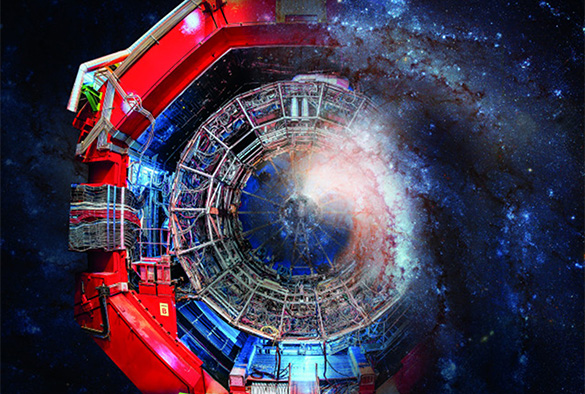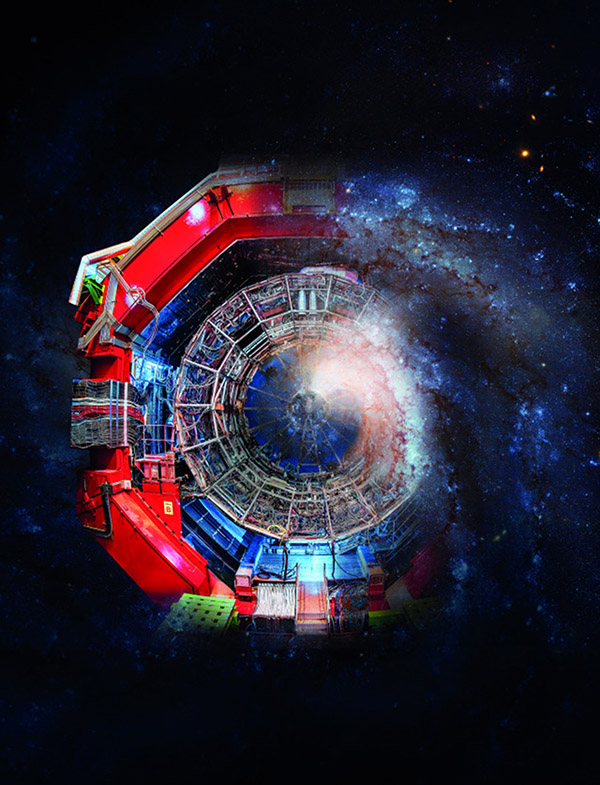ALICE estimates how transparent the Milky Way is to antimatter

The antimatter counterpart of a light atomic nucleus can travel a long distance in the Milky Way without being absorbed, shows the international ALICE collaboration based at AVA partner CERN, in an article published in Nature Physics. The finding, obtained by feeding data on anti-helium nuclei produced at the Large Hadron Collider (LHC) into models, will help space- and balloon-based searches for antimatter that may have originated from dark matter.
Light antimatter nuclei such as anti-deuteron and anti-helium have been produced on Earth, at particle accelerators, but they have yet to be observed with certainty coming from outer space. In space, such anti-nuclei, as well as antiprotons, could be created in collisions between cosmic rays and the interstellar medium, but they could also be produced when hypothetical particles that may make up the dark matter that pervades the Universe annihilate each other.
Space-based experiments such as AMS, which was assembled at CERN and is installed on the International Space Station, are therefore looking for light antimatter nuclei in an effort to search for dark matter, as will the upcoming GAPS balloon mission.
To find out whether dark matter is the source behind any potential detections of light anti-nuclei from outer space, physicists need to determine the number, or more precisely the “flux”, of light anti-nuclei that is expected to reach the near-Earth location of these experiments. This flux depends on features such as the exact type of antimatter source in our Galaxy and the rate at which it produces anti-nuclei, but also on the rate at which the anti-nuclei should later disappear through annihilation or absorption when they encounter normal matter on their journey to Earth.
The latter is where the new study from the ALICE collaboration comes in. By investigating how anti-helium-3 nuclei produced in collisions of heavy ions and of protons at the LHC interact with the ALICE detector, the ALICE researchers were able to measure, for the first time, the rate at which anti-helium-3 nuclei disappear when they encounter normal matter. In this analysis, the ALICE detector’s material serves as the normal matter with which the anti-nuclei interact.

Artist's impression of the ALICE study of the transparency of the Milky Way to antimatter (Image: ORIGINS Cluster, Technical University Munich)
Next, the ALICE researchers incorporated the obtained disappearance rate into a publicly available computer programme called GALPROP, which simulates the propagation of cosmic particles, including anti-nuclei, in the Galaxy. They considered two models of the flux of anti-helium-3 nuclei expected near Earth after the nuclei’s journey from sources in the Milky Way. One model assumes that the sources are cosmic-ray collisions with the interstellar medium, and the other describes them as hypothetical dark-matter particles called weakly interacting massive particles (WIMPs).
For each model, the ALICE team then estimated the transparency of the Milky Way to antihelium-3 nuclei, that is, the Galaxy’s ability to let the nuclei through without being absorbed. They did so by dividing the flux obtained with and without anti-nuclei disappearance.
For the dark-matter model, the ALICE researchers obtained a transparency of about 50%, whereas for the cosmic-ray model the transparency ranged from 25% to 90% depending on the energy of the anti-nucleus. These transparency values show that anti-helium-3 nuclei originating from dark matter or cosmic-ray collisions can travel long distances – of several kiloparsecs – in the Milky Way without being absorbed.
“Our results show, for the first time on the basis of a direct absorption measurement, that anti-helium-3 nuclei coming from as far as the centre of our Galaxy can reach near-Earth locations,” said ALICE physics coordinator Andrea Dainese.
“Our findings demonstrate that searches for light antimatter nuclei from outer space remain a powerful way to hunt for dark matter,” said ALICE spokesperson Luciano Musa.
First measurement of the absorption of anti-3He nuclei in matter and impact on their propagation in the galaxy.
(Video: ORIGINS Cluster, Technical University Munich)
This article is based on an original article published on the CERN website which can be found here